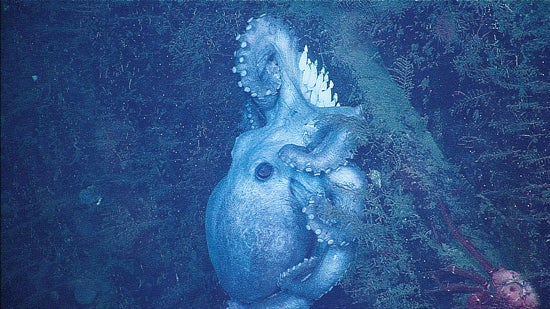Octopus a Devoted Mother

![]() Based on his previous research, both at the University of Rhode Island and at Monterey Bay Aquarium Research Institute before that, URI Associate Professor of Biological Sciences Brad Seibel had predicted that the eggs of some deep-sea octopus species could take years to develop. And, since current knowledge about the octopus is based primarily on shallow-water species, which live just a year or two, Seibel’s prediction also meant the deep-sea cephalopods would have a longer life span than previously thought.
Based on his previous research, both at the University of Rhode Island and at Monterey Bay Aquarium Research Institute before that, URI Associate Professor of Biological Sciences Brad Seibel had predicted that the eggs of some deep-sea octopus species could take years to develop. And, since current knowledge about the octopus is based primarily on shallow-water species, which live just a year or two, Seibel’s prediction also meant the deep-sea cephalopods would have a longer life span than previously thought.
As it turns out, Seibel was right. His former colleagues at Monterey Bay Aquarium Research Institute have observed a deep-sea octopus brooding its eggs for four-and-a-half years—longer than any other known animal. Throughout this time, the female kept the eggs clean and guarded them from predators—a feat representing an evolutionary balancing act between the benefits to the young octopuses of having plenty of time to develop within their eggs, and their mother’s ability to survive for years with little or no food.
Every few months for the last 25 years, a team of Monterey Bay researchers has performed surveys of deep-sea animals at a research site in the depths of Monterey Canyon in the Pacific Ocean. In May 2007, they discovered a female octopus, a species known as Graneledone boreopacifica, clinging to a rocky ledge just above the floor of the canyon, about 4,600 feet below the ocean surface.
Over the next four-and-a-half years, they dove at this same site 18 times, finding the same octopus, identified by her distinctive scars, in the same place. As the young develop inside the eggs, they require plenty of oxygen. This means that the female octopus must continuously bathe the eggs in fresh, oxygenated seawater and keep them from being covered with silt or debris. The female must also guard her eggs vigilantly to prevent them from being eaten by predators. The researchers never saw the female leave her eggs or eat anything, nor did she show any interest in small crabs and shrimp that crawled or swam by, as long as they did not bother her eggs. As the years passed, her translucent eggs grew larger, and the researchers could see young octopuses developing inside, while the female gradually lost weight and her skin became loose and pale.
In September 2011, the researchers saw the brooding octopus for the last time. Just one month later, she was gone, and “the rock face she had occupied held the tattered remnants of empty egg capsules,” according to the researchers’ published paper in the journal PLOS ONE. After counting the remnants of the egg capsules, the researchers estimated that the female octopus had been brooding about 160 eggs. Because the young Graneledone boreopacifica spend so much time in their eggs, by the time they hatch they are fully capable of surviving on their own and hunting for small prey. In fact, the newborns of G. boreopacifica are larger and better developed than the hatchlings of any other octopus or squid.
This research suggests that, in addition to setting records for the longest brooding time of any animal, they may be one of the longest lived cephalopods (a group that includes octopuses, squids, and their relatives). “The ultimate fate of a brooding female octopus is inevitably death,” the researchers wrote, “but in this first example from the deep sea, brooding also confers an extension of adult life that greatly exceeds most projections of cephalopod longevity.”
“This research demonstrates how little we know about life in the deep-sea and life generally. From shallow-living species, we have developed limited and limiting ideas about the capabilities of animals,” said Seibel.
 Home
Home Browse
Browse Close
Close Events
Events Maps
Maps Email
Email Brightspace
Brightspace eCampus
eCampus


